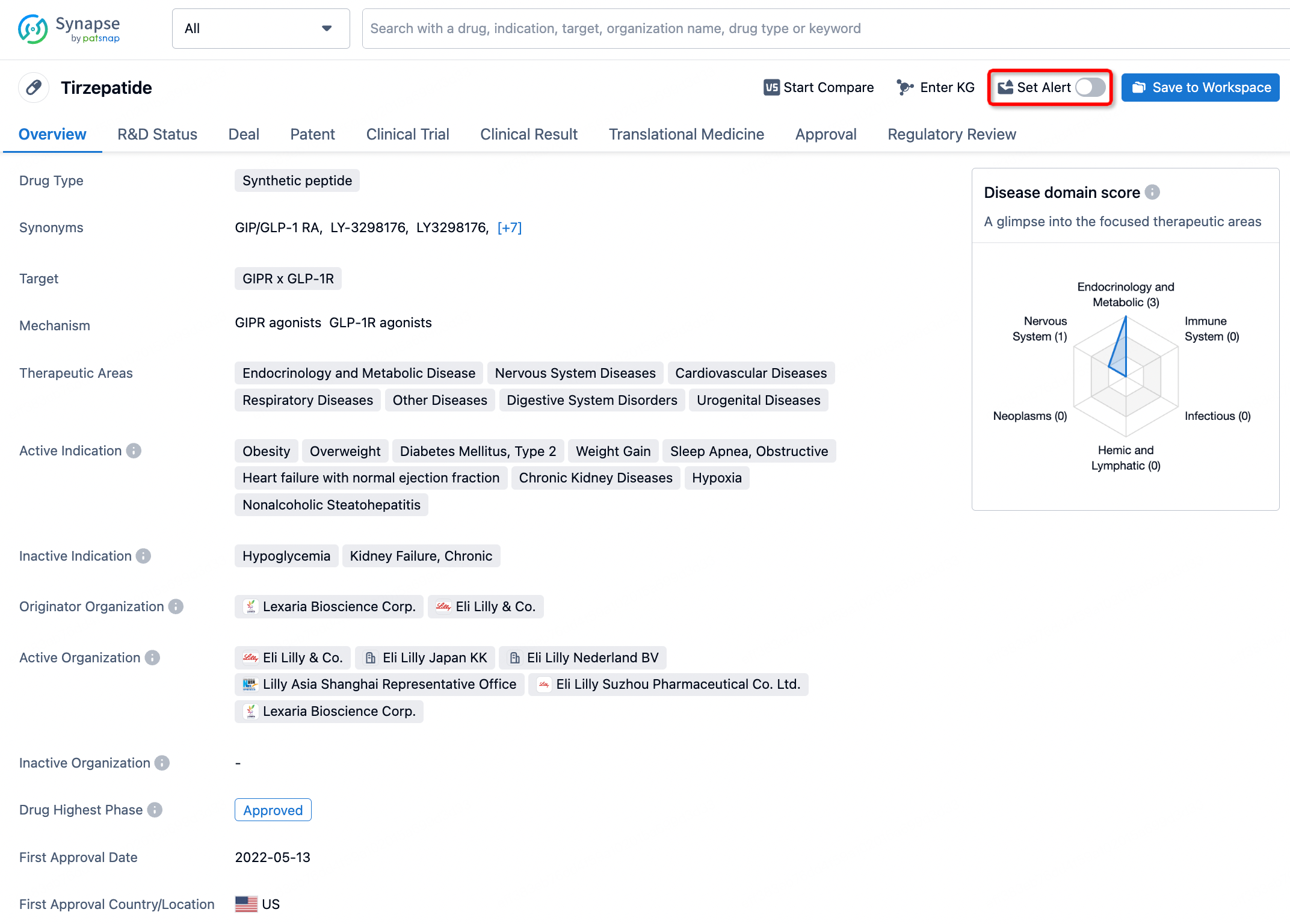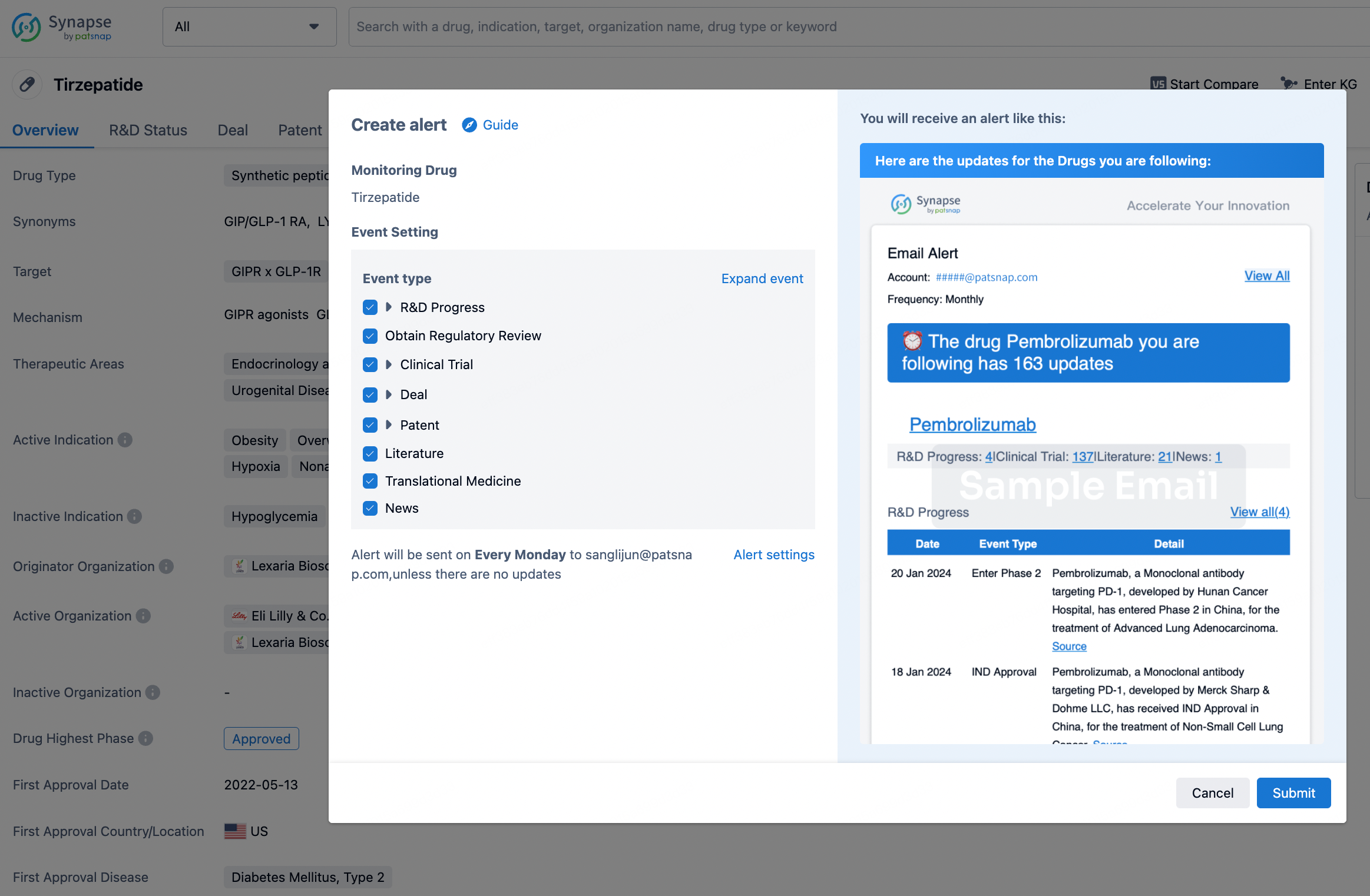Request Demo
What is Clonixin used for?
15 June 2024
Introduction to Clonixin:
Clonixin is a non-steroidal anti-inflammatory drug (NSAID) that has garnered attention in the medical field for its efficacy in managing pain and inflammation. Known by trade names such as Clonix, Clonixine, and Sellesyn, this drug's primary target is cyclooxygenase (COX) enzymes, which play a crucial role in the inflammatory process. Initially developed and researched by pharmaceutical companies like Labaz and later by multinational corporations, Clonixin has established a niche in the realm of analgesics and anti-inflammatory agents. The drug is primarily indicated for the relief of acute pain, musculoskeletal pain, postoperative pain, and dysmenorrhea. Over the years, various clinical trials and research studies have been conducted to understand its efficacy and safety profile better, contributing to Clonixin's reputation as a reliable NSAID.
Clonixin Mechanism of Action:
Clonixin works by inhibiting the activity of cyclooxygenase (COX) enzymes, specifically COX-1 and COX-2. These enzymes are responsible for the conversion of arachidonic acid into prostaglandins, which are lipid compounds that play a significant role in the mediation of inflammation, pain, and fever. By blocking COX enzymes, Clonixin effectively reduces the production of prostaglandins, thereby alleviating inflammation and pain. This mechanism is similar to that of other NSAIDs, but Clonixin is often preferred for its relatively balanced inhibition of both COX-1 and COX-2, which can offer effective pain relief with potentially fewer gastrointestinal side effects compared to selective COX-2 inhibitors.
How to Use Clonixin:
Clonixin is available in various forms, including tablets, capsules, and injectable solutions, providing flexibility in administration based on the clinical scenario. The oral forms are typically administered with water, allowing for ease of use and patient compliance. The standard dosage for adults is usually 125-250 mg taken every six to eight hours, but the exact dosage and frequency should be determined by a healthcare professional based on the patient's condition and response to the medication.
When administered orally, Clonixin's onset of action is relatively rapid, with pain relief typically occurring within 30 to 60 minutes. This makes it an excellent option for acute pain scenarios where prompt relief is desired. For injectable solutions, the onset of action can be even quicker, making it suitable for postoperative pain management or situations where oral administration is not feasible.
Patients are advised to take Clonixin with food or milk to minimize gastrointestinal discomfort, a common side effect associated with NSAIDs. It is crucial to adhere to the prescribed dosage and not to exceed the recommended amount to avoid potential adverse effects.
What is Clonixin Side Effects:
Like all medications, Clonixin is associated with a range of potential side effects, although not everyone will experience them. Common side effects include gastrointestinal disturbances such as nausea, vomiting, diarrhea, and abdominal pain. These are typically mild and can often be mitigated by taking the medication with food.
More severe side effects, although rare, include gastrointestinal bleeding, peptic ulcers, and perforation, which are critical concerns with NSAIDs due to their impact on COX-1, which protects the stomach lining. Patients should be vigilant for signs of gastrointestinal bleeding, such as black, tarry stools or vomiting blood, and seek immediate medical attention if these occur.
Renal impairment is another potential side effect, particularly in patients with pre-existing kidney conditions or those taking other nephrotoxic medications. Regular monitoring of kidney function may be advisable for these patients.
Clonixin may also cause hypersensitivity reactions, ranging from mild skin rashes to severe anaphylactic reactions. Patients with known allergies to NSAIDs should avoid Clonixin and consult their healthcare provider for alternative pain management options.
Contraindications for Clonixin use include a history of gastrointestinal bleeding or ulcers, severe renal or hepatic impairment, and known hypersensitivity to the drug. Pregnant women, particularly in the third trimester, and breastfeeding mothers should avoid using Clonixin due to potential risks to the fetus or infant.
What Other Drugs Will Affect Clonixin:
Clonixin can interact with various other medications, potentially altering its effectiveness or increasing the risk of adverse effects. One of the most significant interactions is with other NSAIDs, such as ibuprofen, naproxen, or aspirin, as concurrent use can amplify the risk of gastrointestinal bleeding and renal impairment.
Anticoagulants, such as warfarin or direct oral anticoagulants (DOACs), can also interact with Clonixin, increasing the risk of bleeding. Patients on these medications should be closely monitored, and dosage adjustments may be necessary to mitigate this risk.
Clonixin may reduce the efficacy of antihypertensive drugs, including ACE inhibitors, angiotensin II receptor blockers (ARBs), and diuretics. This interaction can lead to uncontrolled blood pressure, necessitating close monitoring and possible adjustment of the antihypertensive regimen.
The drug can also interact with certain antidepressants, such as selective serotonin reuptake inhibitors (SSRIs) and serotonin-norepinephrine reuptake inhibitors (SNRIs), increasing the risk of bleeding. Patients on these medications should be aware of this potential interaction and report any unusual bleeding or bruising to their healthcare provider.
Lastly, Clonixin can affect the pharmacokinetics of methotrexate, a drug commonly used in rheumatoid arthritis and certain cancers. Concurrent use can increase methotrexate toxicity, requiring close monitoring and possible dosage adjustments.
In conclusion, Clonixin is a versatile NSAID with a well-established role in managing pain and inflammation. Its balanced inhibition of COX enzymes offers effective pain relief while minimizing some common side effects. However, like all medications, it comes with potential risks and interactions that require careful consideration and management by healthcare professionals to ensure patient safety and optimal therapeutic outcomes.
Clonixin is a non-steroidal anti-inflammatory drug (NSAID) that has garnered attention in the medical field for its efficacy in managing pain and inflammation. Known by trade names such as Clonix, Clonixine, and Sellesyn, this drug's primary target is cyclooxygenase (COX) enzymes, which play a crucial role in the inflammatory process. Initially developed and researched by pharmaceutical companies like Labaz and later by multinational corporations, Clonixin has established a niche in the realm of analgesics and anti-inflammatory agents. The drug is primarily indicated for the relief of acute pain, musculoskeletal pain, postoperative pain, and dysmenorrhea. Over the years, various clinical trials and research studies have been conducted to understand its efficacy and safety profile better, contributing to Clonixin's reputation as a reliable NSAID.
Clonixin Mechanism of Action:
Clonixin works by inhibiting the activity of cyclooxygenase (COX) enzymes, specifically COX-1 and COX-2. These enzymes are responsible for the conversion of arachidonic acid into prostaglandins, which are lipid compounds that play a significant role in the mediation of inflammation, pain, and fever. By blocking COX enzymes, Clonixin effectively reduces the production of prostaglandins, thereby alleviating inflammation and pain. This mechanism is similar to that of other NSAIDs, but Clonixin is often preferred for its relatively balanced inhibition of both COX-1 and COX-2, which can offer effective pain relief with potentially fewer gastrointestinal side effects compared to selective COX-2 inhibitors.
How to Use Clonixin:
Clonixin is available in various forms, including tablets, capsules, and injectable solutions, providing flexibility in administration based on the clinical scenario. The oral forms are typically administered with water, allowing for ease of use and patient compliance. The standard dosage for adults is usually 125-250 mg taken every six to eight hours, but the exact dosage and frequency should be determined by a healthcare professional based on the patient's condition and response to the medication.
When administered orally, Clonixin's onset of action is relatively rapid, with pain relief typically occurring within 30 to 60 minutes. This makes it an excellent option for acute pain scenarios where prompt relief is desired. For injectable solutions, the onset of action can be even quicker, making it suitable for postoperative pain management or situations where oral administration is not feasible.
Patients are advised to take Clonixin with food or milk to minimize gastrointestinal discomfort, a common side effect associated with NSAIDs. It is crucial to adhere to the prescribed dosage and not to exceed the recommended amount to avoid potential adverse effects.
What is Clonixin Side Effects:
Like all medications, Clonixin is associated with a range of potential side effects, although not everyone will experience them. Common side effects include gastrointestinal disturbances such as nausea, vomiting, diarrhea, and abdominal pain. These are typically mild and can often be mitigated by taking the medication with food.
More severe side effects, although rare, include gastrointestinal bleeding, peptic ulcers, and perforation, which are critical concerns with NSAIDs due to their impact on COX-1, which protects the stomach lining. Patients should be vigilant for signs of gastrointestinal bleeding, such as black, tarry stools or vomiting blood, and seek immediate medical attention if these occur.
Renal impairment is another potential side effect, particularly in patients with pre-existing kidney conditions or those taking other nephrotoxic medications. Regular monitoring of kidney function may be advisable for these patients.
Clonixin may also cause hypersensitivity reactions, ranging from mild skin rashes to severe anaphylactic reactions. Patients with known allergies to NSAIDs should avoid Clonixin and consult their healthcare provider for alternative pain management options.
Contraindications for Clonixin use include a history of gastrointestinal bleeding or ulcers, severe renal or hepatic impairment, and known hypersensitivity to the drug. Pregnant women, particularly in the third trimester, and breastfeeding mothers should avoid using Clonixin due to potential risks to the fetus or infant.
What Other Drugs Will Affect Clonixin:
Clonixin can interact with various other medications, potentially altering its effectiveness or increasing the risk of adverse effects. One of the most significant interactions is with other NSAIDs, such as ibuprofen, naproxen, or aspirin, as concurrent use can amplify the risk of gastrointestinal bleeding and renal impairment.
Anticoagulants, such as warfarin or direct oral anticoagulants (DOACs), can also interact with Clonixin, increasing the risk of bleeding. Patients on these medications should be closely monitored, and dosage adjustments may be necessary to mitigate this risk.
Clonixin may reduce the efficacy of antihypertensive drugs, including ACE inhibitors, angiotensin II receptor blockers (ARBs), and diuretics. This interaction can lead to uncontrolled blood pressure, necessitating close monitoring and possible adjustment of the antihypertensive regimen.
The drug can also interact with certain antidepressants, such as selective serotonin reuptake inhibitors (SSRIs) and serotonin-norepinephrine reuptake inhibitors (SNRIs), increasing the risk of bleeding. Patients on these medications should be aware of this potential interaction and report any unusual bleeding or bruising to their healthcare provider.
Lastly, Clonixin can affect the pharmacokinetics of methotrexate, a drug commonly used in rheumatoid arthritis and certain cancers. Concurrent use can increase methotrexate toxicity, requiring close monitoring and possible dosage adjustments.
In conclusion, Clonixin is a versatile NSAID with a well-established role in managing pain and inflammation. Its balanced inhibition of COX enzymes offers effective pain relief while minimizing some common side effects. However, like all medications, it comes with potential risks and interactions that require careful consideration and management by healthcare professionals to ensure patient safety and optimal therapeutic outcomes.
How to obtain the latest development progress of all drugs?
In the Synapse database, you can stay updated on the latest research and development advances of all drugs. This service is accessible anytime and anywhere, with updates available daily or weekly. Use the "Set Alert" function to stay informed. Click on the image below to embark on a brand new journey of drug discovery!
AI Agents Built for Biopharma Breakthroughs
Accelerate discovery. Empower decisions. Transform outcomes.
Get started for free today!
Accelerate Strategic R&D decision making with Synapse, PatSnap’s AI-powered Connected Innovation Intelligence Platform Built for Life Sciences Professionals.
Start your data trial now!
Synapse data is also accessible to external entities via APIs or data packages. Empower better decisions with the latest in pharmaceutical intelligence.


